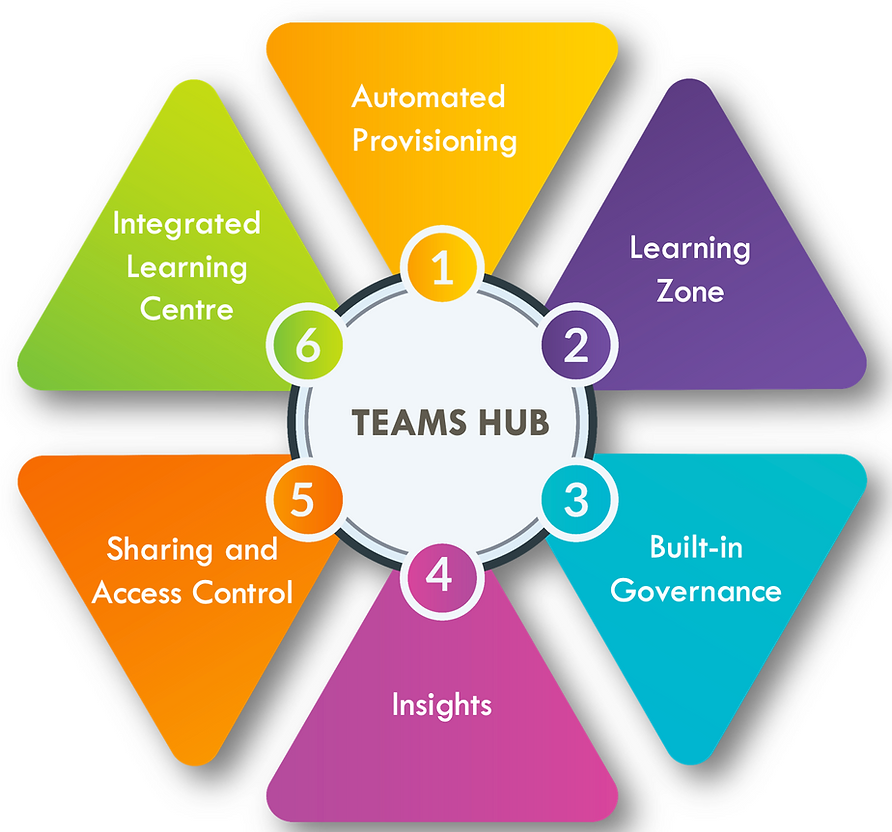![]()
Perhaps, the most important part of information governance is the use site / Teams’ templates. These templates define the structure of your site or team. Consider it is as a sketch of the site / team that tells you what components will be included when the template is deployed.
For SharePoint site it means that you can define artefacts like the site content types, site column, navigation, lists & libraries which get created each time a site gets provisioned using the template.
For Teams, it means that we can define the channels that get created, the default apps that will be added to teams when the template is deployed.
Templates form one of the fundamental aspects to implement an Information Architecture in Microsoft 365.

Broadly, there are three kinds of templates that are present.
Out of the box templates are the one’s that come with the product when it’s installed for the users in your tenant. For instance, SharePoint comes with various site templates like the Modern Team sites or Communication sites both of which serve different purpose and deploy different libraries, lists and webparts for instance. In case of Teams, there are out of the box templates like “Onboard Employees” template, that aims at streamlining employee onboarding or “Manage an event” which sets you up with the necessary collaboration apps by default. All these templates come with pre-defined channels and apps out of the box.
Then there are the SharePoint experience templates which are based on varied business solutions. These are also called as the lookbook templates provided by Microsoft. You can use these templates for creating modern experiences for solutions like Crisis Communication, Intranets with zero customizations. At Infotechtion, we have built an Intranet solution taking inspiration from the lookbook templates and extended it with all the necessary information architecture components in place.
Coming to the most important one, which are the custom templates that provide you with complete control to define which components of site or teams get provisioned. For instance, Using the SharePoint site templates you can define your own content types, site columns, navigation and so on which form the basis of your Information Architecture. You can also create standardized custom templates at the organizational level or for each business unit that can inherit some components from the organizational level template.

So why are templates the go to path for Information Governance in SharePoint & Teams –
First off, templates provide a mechanism by which you can standardize your metadata model and the information architecture across all the sites / teams that get provisioned based on the template.
This also provides a way for you to ensure that you achieve compliance by design meaning there are no functional silos, all the business units talk in a similar structured fashion improving interoperability, which ultimately leads to the circulation of organizational vision and knowledge.
Since templates provide consistency in the way information that will be obtained from end users is stored , it results in ease of access, better search and filtering of information.
You can define security requirements of your SharePoint site as a part of the template. For instance, lets consider that for each site that gets provisioned using the template should have a highly confidential library and it needs to have its permissions broken such that only the site owners should have access to that library. Templates make all such scenarios possible.
If you are looking to build SharePoint sites or create teams for specific types of projects, then templates are the best fit for the job. Most of the organizations carry out projects that are repeatable and are similar in nature. Templates are a great way to standardize such project sites.
The deployment of sites, getting them up and running is faster with Templates. templates also provide a mechanism by which you can achieve a uniform look and feel, a consistent branding that can be tailored to your organizations branding guidelines. templates are also maintainable and makes it easy to enhance the site / teams with additional features.

Let’s look at the various ways to deploy templates.
Out of the box templates like Teams sites , communication sites for SharePoint, or employee onboarding & help desk for Teams, can be provisioned using the User Interface or programmatically. They are standard and ready to use templates built right into the product. They form the basis for defining custom templates as well.
SharePoint Experience Templates like the crisis communication template have been open sourced by Microsoft. They are available via the lookbook Microsoft site. These are easy to setup as the whole deployment is a single click process. You can deploy to the tenant of your choosing and within a few minutes you will have the site with all the necessary artefacts deployed to your tenant. They are a great way to get inspiration to start designing the template that you deem fit for your organization.
Custom templates can be provisioned programmatically for both SharePoint and Teams. The teams admin center also allows us to create custom teams templates using the User interface and one can define the default channels and apps to be provisioned right from there.

Templates and provisioning framework are used together to achieve a good governance model. While Templates allow you to standardize the structure, navigation, look and feel and other elements of the site / Teams. A good provisioning framework will assist you in capturing metadata during the provisioning process. This metadata can then form the basis on which you apply automated retention settings and automated information protection policies. For instance, you might want to apply a confidential label to all the sites that belong to the Finance business unit or you want to retain the information in a HR site for 10 years, all such stuff can be automated during provisioning. The provisioning framework will even allow you to embed approvals before a site or team is provisioned, this helps you manage the proliferation of sites / teams. Another advantage of having a robust provisioning framework is that it allows you to apply templates to SharePoint sites that were created due to the creation of teams. All this resulting in a better governance model to manage the lifecycle of a site / team, right from creation to archival.

Let us now have a look at Teams hub which is an open-source product from Infotechtion, built on Microsoft power platform to accelerate governance deployment and ongoing operational governance in Microsoft 365. The key is to focus on making it easy for users to integrate sufficient guidance and governance to maintain long term team effectiveness.
Automate manual tasks involved in the creation and setup of Teams with seamless access to create/request a new Team. This enables enterprises to assess the requirements, and automatically apply naming, security, taxonomy, and compliance controls when a new Team is created. You can also enhance the experience by using predefined templates for a seamless experience leveraging existing M365 features.
Teams Hub features a Learning Zone to provide a tailored learning experience for the entire organization. It provides integrated user guidance and training videos directly in Microsoft teams. We all know how rapidly Microsoft Teams evolves, so you also receive automated quarterly updates on Teams learning content and videos directly from Microsoft.

With the ability to choose the template before creation of Teams and the ability to decide the archival mechanism based on the metadata during provisioning, you get embedded governance features.
Teams Hub provides a single interface to extract key insights about Teams and associated compliance for your compliance and governance stakeholders. Teams Hub leverages the existing analytics provided by Microsoft and an open platform to surface additional insights as defined by your Information governance standards.
External Sharing can be setup based on your preference during provisioning; Teams Hub provides you with the ability to switch guest access based on your team requirements.
Teams hub also provides a centralized knowledge hub. For instance, you can publish Tips & Tricks to all the users in your organization about how to best work with Microsoft Teams.
Here is a video demonstration of Infotechtion Teams Hub.
Please contact us to discuss how your organization can leverage the open source Infotechtion Teams Hub.



